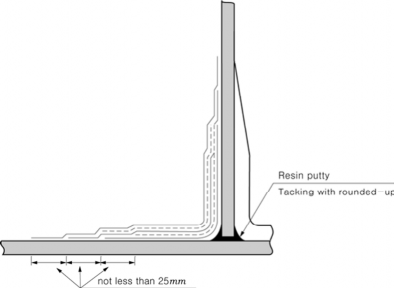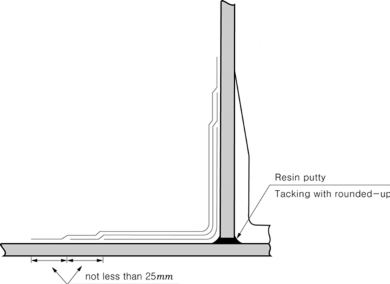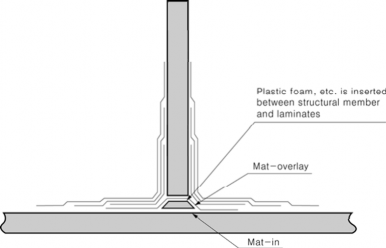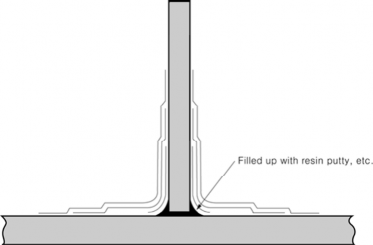

< Previous | Contents | Next >
Section 7 Bonded Connections
701. T-joints
1. The overlap
4.1.
width of T-joints of structural members are generally to be in accordance with Fig

Fig 4.1 Dimensions of Overlap of T-Joints
2. In T-joints of members of sandwich construction, the aggregated thickness of the inner laminate and the outer laminate of FRP may be used as the thickness (t) shown in Fig 4.1.
3. The form of laminating of T-joints is to be as shown in Fig 4.2(a) and Fig 4.2(b).
![]()

Fig 4.2(a) In Case Chopped Mats and Roving Cloths are jointly used

Fig 4.2(b) In Case Chopped Mats are used
4. Where the heavy load
members such as engine girders, bulkheads, etc., which are subjected to considerably or vibration are connected, careful considerations are to be given in such a manner as
to arrange structural members upon the laminates which are increased in thickness as shown in Fig
4.3(a).
5. Where the members other than those specified in the preceding 4, that is, the members which are not deemed subjected to specially heavy load or vibration, are connected to the structural members, plastic foams or other similar materials are to be inserted between the member and the laminate as shown in Fig 4.3(b) or the corners are to be sufficiently laminated by filling with soft resin puttys or other similar materials as shown in Fig 4.3(c).
![]()

Fig 4.3(a) In Case Consideration is to be paid to Load or Vibration

Fig 4.3(b) Standard Form of T-Joints

Fig 4.3(c) Standard Form of T-Joints
![]()
702. L-Joints 【See Guidance】
L-Joints are generally not to be used for primary structural members. Where, however, L-Joints are inevitably used because adoption of T-Joints is difficult, the careful consideration is to be paid to the construction of the joints.
703.
Butt Joints
1. In the shell laminates, butt joints are not to be provided. However, in case of repair, etc., where joints are locally provided, scarph joints may be used.
2. In the butt joints of deck laminates, joints other than scarph joints of V-type or X-type are not to be used.
(1) Solid lines indicate chopped mat layers and dotted lines indicate roving cloth layers.
(2) Roving cloth layers are not to overlap each other.
(3) The first and last layers are to be a chopped mat layer.